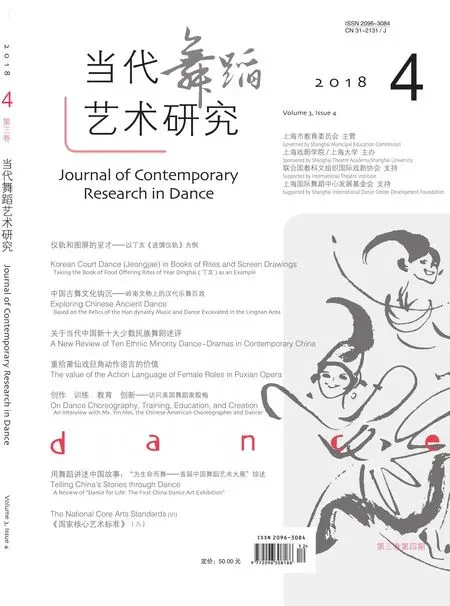卷首语
无疑作为一种创新视角和理念,中国政府倡导的“人类命运共同体”意识在世界多极化、经济全球化、社会信息化、文化多样化的国际形势下,为应对人类生存的严峻挑战提供了重要的思想策略。正如习近平所说,国际社会日益成为一个你中有我、我中有你的“命运共同体”,面对世界经济的复杂形势和全球性问题,任何国家都不可能独善其身,因为,人类只有一个地球。显然,这一创新视角和理念不仅对于国家间的政治、经济、文化、外交、民生等问题的解决行之有效,对于舞蹈文化艺术的生存发展问题的解决也行之有效。由于全世界的舞者亦生活在当下同一个世界,因而都不得不共同面对人类的身体和灵魂健康发展的种种问题。
尽管“全球化”的概念出现于20世纪90年代之后,然而,即使在马云所说的“马可·波罗从欧洲来到中国花8年时间,再用8年时间从中国返回欧洲”的时代,国与国之间为了谋求生存和发展,彼此间的交流、学习、合作也持续不断,因而由政治、贸易、文化交往而形成了“国际化”的概念。而由中国开辟的“丝绸之路”更是一个典范。国与国的通商与文化交流频繁,以至于当今世界不少国家的历史与文化间存在诸多“你中有我,我中有你”的情况。
世界舞蹈文化领域的交流和发展不外于此。历史上的文化交流曾经促使欧洲共同的古典舞蹈生成:芭蕾舞萌生于意大利,成熟于法国,鼎盛于俄国,渐行于欧美,而在当代,则风靡于世界各国。芭蕾舞不仅是欧洲亦是世界舞蹈的共同财富和艺术明珠。历史上的文化交流也使得亚洲的古典舞蹈之间有着千丝万缕的联系。中国唐代宫廷乐舞中就有来自印度、越南、乌兹别克斯坦、朝鲜半岛等诸多不同国家或地域的乐舞。而日本、韩国、越南等国则将中国的唐宋宫廷乐舞学演、传承至今,并在其深刻影响之下,创造了本土的宫廷乐舞和古典乐舞,作为亚洲共同的非物质文化遗产和财富,业已被联合国教科文组织列入人类非物质文化遗产代表作名录。
舞蹈艺术“国际化”汹涌的浪潮在近现代伴随着救国救亡者求索的脚步、传教士布道的“福音”、侵略者的铁蹄及殖民者的文化的输入纷沓而至。各种流行歌舞挟裹着异国文化如洪水般涌入殖民地,改变着殖民地的舞蹈文化发展的方向,亦反向影响、改变着宗主国自身的文化发展方向。而20世纪以来,东西方现代舞蹈大师们的艺术创新和文化转型无一不得益于东西方文化的交流和融汇。
全球化的大潮和科技革命,更是让世界各国间距离缩短,世界成为一个“地球村”。而今,在互联网时代—从欧洲“8秒钟都能抵达中国几亿次”(马云语)的时代,世界文化的交流和融汇更是势不可挡!“开放”“交流”“同心”“合作”“共赢”“尊重”“理解”“独立”“多样”“创新”等等,都将是我们行动的指南,也将是我们生存策略中的关键词。
作为置身于“人类命运共同体”中的一粒微小分子,《当代舞蹈艺术研究》用中英双语的创刊以对应这个日益扩大的全球化趋势,追求“一种以应对人类共同挑战为目的的全球价值观”。除了组织并推介报道诸如“2017·国际舞蹈日庆典‘我们一起舞’”“国际舞蹈论坛:全球化时代舞蹈多样性发展”等多种国际活动专题、双语连载美国《国家核心艺术标准》的全文、推荐来自世界不同国家和地区学者们的研究成果等,今后我们将进一步打开刊物的国际化视野,继续“以当代的视野审视舞蹈,以舞蹈的身体认知世界”。
而今,在本刊创刊两周年之际推出的“东亚论坛”系列,探究这一历史上大多处于“海上丝路”东海航线之上的国家间历史上的乐舞文化交流、融合及本土建设和发展,对于这一政治、经济、外交、文化联系紧密的区域诸国联袂追溯历史、审视现实、展望未来,加强传统文化保护,实现文化创新,共建区域文化,推进区域与世界和平均具有极其重要的意义。或许,这也是舞蹈学界对于“人类命运共同体”建设的又一次积极的践行。
—本刊主编
Preface
As a new perspective and innovative concept, the Community of Shared Future proposed by the Chinese government offers a solution to the severe challenges to human survival in the context of world multi-polarization, economic globalization, social digitalization and cultural diversity.As President Xi Jinping once said, the international community has become a “community of shared future” in which everyone has in himself a little bit of others.In the face of the complex challenges to the world economy, no country can exist alone as an “island.” After all, humans have only one earth.Obviously, this innovative concept does not only apply to the political, economic, cultural, and diplomatic relations among countries, but is also are highly relevant to the development of dance culture and art.Since dancers share one world, they must address the healthy development of human body and soul together.
Although the concept of “globalization” didn’t appear until the late 1990s, countries had all along learned from each other, communicated and cooperated with each other to seek for survival and development, which has given rise to the concept of political, trading and cultural internationalization, even though Jack Ma mentioned that “it took Marco Polo 8 years to come to China from Europe, and again 8 years to return to Europe from China.” The Silk Road opened by China is a great example.International commercial and cultural exchanges have become so frequent that “everyone has in himself a little bit of others” in terms of history and culture.
The culture of dance is surely a key area ofinternational communication and globalized development.Cultural exchanges had led to the creation of a common European classical dance.Ballet was born in Italy, matured in France, prospered in Russia, gradually spread in Europe and America, and now it is popular all over the world.So,ballet is not exactly European; it is global, a common artistic asset of the world.Cultural exchanges have produced interconnections among the classical dances of Asia.In the Tang dynasty, China imported music and dance from India,the Korean Peninsula, Vietnam, and Uzbekistan which became integral elements of Chinese court music and dance,and then during the Tang and Song dynasties China exported court music and dance to Japan, Korea and Vietnam which had created their own court music and dance as well as classical music and dance under the inf luence of the imports from China.These music and dance traditions have been highly recognized as common intangible cultural heritage of Asia and included in the UNESCO list of intangible cultural heritage.
Dance “internationalization” once came in the footsteps of national salvation, missionary evangelism and colonialism.In the case of colonialism, music and dance had flooded into colonies as part of forced cultural import, which changed the local dance culture and the cultural development of the colonizers.Since the 20th century, artistic innovation and cultural transformation in the East and the West have benef ited from the exchange and blending of cultures.
Meanwhile, technological revolutions have shortened the distance between countries and rendered the big world a “global village.” In the current era of the Internet, it takes only 8 seconds to travel between Europe and China hundreds of millions of times, according to Jack Ma.In this era global cultural exchange and integration are even more overwhelming.The buzz words “open,”“communication,”“sharing,”“cooperation,”“win-win,”“respect,”“understanding,”“independence,”“diversity” and “innovation” will guide our actions.They are also the key words of our values.
As a tiny molecule in the “community of shared future,”the Chinese-English bilingual Journal of Contemporary Research in Dance tries to follow the “globalization”trend and seek to address the common challenges of mankind.Like the previous issues that focused on 2017 International Day and the International Dance Forum: Diversified Development of Dance in the Age of Globalization, the issue will further enhance its internationalization level and continue to examine the art of dance with a contemporary and global vision and examine the world through dance body.It continues to carry the bilingual National Core Standards of Art Education of the United States and introduce the latest results of research and innovation by dancers and scholars around the world.
Coinciding with the second anniversary of the journal,the “East Asia Forum” on dance was held to explore the music and dance exchanges and integration along the East China Sea route of the “Maritime Silk Road.”It is of great importance for these countries with close political, economic, diplomatic and cultural links to trace the history, examine the reality, look towards the future,strengthen the protection of heritage, promote cultural innovation and build a shared regional culture.It is also helpful for promoting regional and world peace.This is a positive contribution of the dance community to building the “community of shared future.”
— Editor-in-Chief

